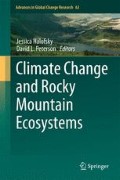Abstract
Cultural resources in the Northern Rockies are currently vulnerable to various natural and human agencies, including wildfire and biological processes, vandalism and other depreciative human behaviors, and changing population demographics and recreational use. Climate change has the potential to accelerate some of these ongoing effects to cultural resources. Increasing wildfires will have a direct effect on cultural resources, because they are broadly distributed throughout forest and grassland ecosystems. Melting ice caused by climate change poses a risk to previously ice-encased and well-preserved cultural resources. Seasonal aridity and prolonged drought will accelerate soil deflation and erosion, and expose archaeological sites once buried in prairie or mountain soils. At the same time, a projected increase in winter precipitation, coupled with earlier and more intense spring runoff, poses another threat to cultural resources. Climate-induced changes in terrestrial and aquatic habitats also affect abundance of culturally-valued plants, animals and fish, affecting the ability of Native American tribes to exercise their treaty rights.
Damage to cultural and historic sites is irreversible, making protection a key management focus. To some extent, wildfire effects can be mitigated through active prevention measures (for example, thinning trees around historic structures) and fire suppression and recovery tactics. Hydrological events are unpredictable, and protection measures such as stabilization and armoring are expensive. Nonetheless, federal agencies have a strong mandate to implement measures to protect cultural sites threatened by such natural processes and emergency events. Survey and evaluation in areas where cultural resources are concentrated or likely is ongoing, although intermittent, in the Northern Rockies. It will be possible to locate and monitor cultural resources only if these efforts are significantly expanded.
Access this chapter
Tax calculation will be finalised at checkout
Purchases are for personal use only
References
DeMallie, R. J. (Ed.). (2001). Handbook of North American Indians: Plains, volume 13. Washington, DC: Smithsonian Institution.
Fagan, B. M. (1990). The journey from Eden: The peopling of our world. London: Thames & Hudson.
Intergovernmental Panel on Climate Change (IPCC). (2007). The physical science basis. Contribution of Working Group I to the Fourth Assessment Report of the Intergovernmental Panel on Climate Change. S. Solomon, D. Qin, M. Manning, et al. (Eds.) Cambridge, UK: Cambridge University Press.
Lee, C. M. (2012). Withering snow and ice in the mid-latitudes: A new archaeological and paleobiological record for the Rocky Mountain region. Arctic, 65, 165–177.
Logan, J., & Powell, J. (2001). Ghost forests, global warming, and the mountain pine beetle (Coleoptera: Scolytidae). American Entomologist, 47(3), 160–173.
Mayewski, P. A., & White, F. (2002). The ice chronicles: The quest to understand global climate change. Hanover, NH: University of New Hampshire Press.
McKenzie, D., Gedalof, Z., Peterson, D. L., & Mote, P. (2004). Climatic change, wildfire, and conservation. Conservation Biology, 18(4), 890–902.
Melnick, R. Z. (2009). Climate change and landscape preservation: A twenty-first century conundrum. APT Bulletin: Journal of Preservation Technology, 40(3-4), 34–43.
Meltzer, D. J. (1990). Human responses to middle Holocene (Altithermal) climates on the North American Great Plains. Quaternary Research, 52, 404–416.
Meltzer, D. J. (2009). First peoples in a new world: Colonizing ice age America. Berkeley: University of California Press.
Morgan, M., Rockman, M., Smith, C., & Meadow, A. (2016). Climate change impacts on cultural resources (Cultural resources partnerships and science). Washington, DC: National Park Service.
National Park Service (NPS). (1994). Protecting cultural landscapes: Planning, treatment and management of historic landscapes (Preservation Brief 36). Washington, DC: National Park Service.
National Park Service (NPS). (2011). Cultural resources, partnerships and science directorate. http://www.nps.gov/history/tribes/aboutus.htm. 30 Jan 2017.
National Park Service (NPS). (2015a). Archaeology program–Antiquities Act 1906–2006. http://www.nps.gov/archeology/sites/antiquities/about. 30 Jan 2017.
National Park Service (NPS). (2015b.) Glacier National Park: What are cultural resources? http://gnpculturalresourceguide.info/files/resources/What%20Are%20Cultural%20ResourcesFinal.pdf. 30 Jan 2017.
National Research Council. (2002). Abrupt climate change: Inevitable surprises. Washington, DC: National Academy Press.
Nickerson, N. P. (2014). Travel and recreation in Montana: 2013 review and 2014 outlook. Missoula: University of Montana, College of Forestry and Conservation.
Rockman, M. (2015). An NPS framework for addressing climate change with cultural resources. The George Wright Forum, 32(1), 37–50.
Ruddiman, W. F. (2007). Earth’s climate: Past and future. New York: W. H. Freeman.
Schleiser, K. H. (1994). Plains Indians, A.D. 500-1500: The archaeological past of historic groups. Norman: University of Oklahoma Press.
Schoennagel, T., Verblen, T. T., & Romme, W. H. (2004). The interaction of fire, fuels, and climate across Rocky Mountain forests. Bioscience, 54(7), 661–676.
Tomback, D. F., & Kendall, K. C. (2001). Biodiversity losses: The downward spiral. In D. F. Tomback, S. F. Arno, & R. E. Keane (Eds.), Whitebark pine communities: Ecology and restoration (pp. 243–262). Washington, DC: Island Press.
U.S. Forest Service (USFS). (2008). Forest service manual, FSM-recreation, wilderness, and related resource management, chapter 2360-heritage program management. Washington, DC: National Headquarters.
United Nations Educational, Scientific, and Cultural Organization (UNESCO). (2007). Climate change and world heritage: Report on predicting and managing the impacts of climate change on world heritage and strategy to assist states parties to implement appropriate management responses (World Heritage Report 22). Paris: UNESCO, World Heritage Centre.
Walker, D. E. (Ed.). (1988). Handbook of North American Indians: Plains, volume 12. Washington, DC: Smithsonian Institution.
White, R. (1993). It’s your misfortune and none of my own: A new history of the American West. Norman: University of Oklahoma Press.
Author information
Authors and Affiliations
Corresponding author
Editor information
Editors and Affiliations
Rights and permissions
Copyright information
© 2018 Springer International Publishing AG
About this chapter
Cite this chapter
Davis, C.M. (2018). Effects of Climate Change on Cultural Resources in the Northern Rockies. In: Halofsky, J., Peterson, D. (eds) Climate Change and Rocky Mountain Ecosystems. Advances in Global Change Research, vol 63. Springer, Cham. https://doi.org/10.1007/978-3-319-56928-4_11
Download citation
DOI: https://doi.org/10.1007/978-3-319-56928-4_11
Published:
Publisher Name: Springer, Cham
Print ISBN: 978-3-319-56927-7
Online ISBN: 978-3-319-56928-4
eBook Packages: Earth and Environmental ScienceEarth and Environmental Science (R0)

